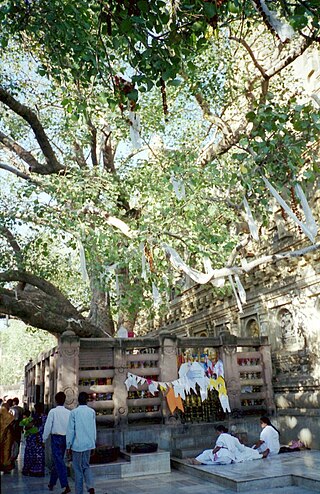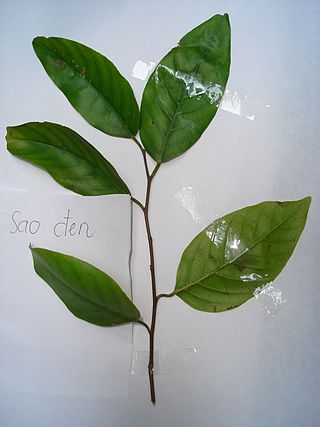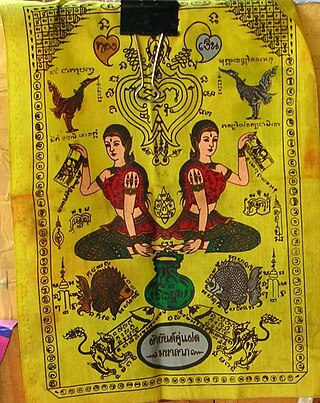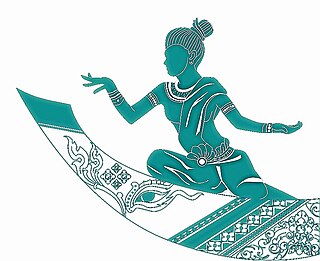
Nang Mai (Thai : นางไม้) is a ghost from Thai folklore that inhabits a large tree. It builds a palace in the tree, but nobody can see it, and if anyone cuts that tree, the cutter will be cursed, grow sick, or even become crazy.

Nang Mai (Thai : นางไม้) is a ghost from Thai folklore that inhabits a large tree. It builds a palace in the tree, but nobody can see it, and if anyone cuts that tree, the cutter will be cursed, grow sick, or even become crazy.
Nang mai in Thai folklore, is said to be a young woman wearing a pleated robe and covering herself in a sash with shoulder-length hair. Nang mai can also be a male, and they would be called Rukkhadeva (Thai: รุกขเทวดา)., who would mostly inhabit a banyan tree or in a large tree, but Nang mai would mostly live in a smaller size tree. If someone in a village saw Nang mai inhabiting a tree, they would bring a 3-colour cloth to tie up the tree. [1]
In Thailand people believe there is a good Nang mai who will warn their owner, who takes good care of them, of any upcoming danger, and an evil Nang mai who will lure men to make them their husband or to just kill them. Nang Tani and Nang Ta-khian are also considered a Nang mai but the spirit of a person who kills themselves and their spirit is stuck with that tree is not considered a Nang mai.
The Nang Ta-khian version of Nang mai or Nang mai who inhabits a large tree is considered to be one of the most hostile Nang mai because they believe that the larger the tree, the older and more haunting it is. Some people also say that the more sap the tree produces, the more haunting the Nang mai who live in it are. [2]
According to legend, a daughter of Nakhon Si Thammarat's monarch was kidnapped to loot and demand ransom. But the king's daughter was killed during the journey, and her body was hidden in the hollow of a big mango tree. Her ghostly spirit demonstrated her strength after her death; afterward, people respected and worshiped her. The family in a nearby village will bring their son to the ceremonies to introduce them to her so that she can protect them. They will have the man undertake marriage ceremonies with the spirit when he reaches marriageable age. The male who undertakes marriage ceremonies with Nang mai can marry another lady, but if their firstborn child is a boy, the boy must complete the wedding ceremonies with the Nang mai.
However, if the child does not execute the marriage ceremonies, the family will face an unfavorable occurrence until the wedding ceremony is performed. The family must prepare an offering of a tray of gifts, money, and sacrifice, such as pig head, booze, duck, chicken, fruit, and so on, for the wedding ceremonies. Weddings are only to be performed on Tuesdays and Saturdays. The groom must dress politely, as in a traditional Thai wedding ceremony, but he will also carry a dagger. There will also be a Khan Mak procession ceremony, which will be conducted in an entertaining manner. There is also a folklore of a woman who makes a wish to the ghost and it comes true. As a result, she must fulfill a pledge to the ghost by disguising as a man and marrying the ghost. [3]

In Thai beliefs, Nang Mai had the power to make people fear cutting down trees. They could cast a spell to make people who cut down trees sick or go insane and lose their minds. Nang Mai's sacredness is most likely related to the type and size of the tree. Takhian trees is a high-quality wood with a large trunk, so the ghost who guards it must be a great spirit and very sacred in order to keep this type of tree from being cut down easily. If people want to cut down large trees in the forest, they must first perform a ceremony to ask for forgiveness.
Even Buddhism, which has power over animism, reflects that in order to fight the power of the holy spirits residing in the trees, a compromise method must be used because the spirits residing in the trees are extremely powerful. The Bhutakam Sikkhabha precepts state that monks are not permitted to cut the grass or trees while they are still fresh and green. [4]
Nowadays, Thai people like to pay homage to large trees by offering Thai costumes, perfumes, and make-up sets. They believe that sacred spirits can be found in large trees. Furthermore, many people believe that Nang Mai or Rukkhadeva, who live in trees, are sacred. and believe that they can improve the lives of those who worship them.
Sao Ronghai is one of Thailand's most popular Nang Mai shrines. It is located at Wat Sung, Tambon Sao Hai, in the Chao Mae Takhian Tong Shrine. It is a large pillar that is believed to be a female spirit because the offerings made to it are all female item. According to legend, when Bangkok was established as the capital, a decree was issued that the most beautiful pillars from across the country would be brought to Bangkok for selection as the City Pillar. Saraburi sent a large Takhian Thong wooden pole discovered in the Dong Phaya Yen forest (Muak Lek) sailing down the Pa Sak River. This pillar traveled all the way to Bangkok and was chosen as the first pillar. However, the authorities complained that the pole's tip was crooked. As a result, it was eliminated from consideration. Because of this, the spirit who resided within the tree became depressed. Crying and floating upstream from Bangkok to the Pa Sak River, it lands in front of the Sao Hai District Office. At the time, the villagers heard the sound of a woman crying near the river and went out to take a look. A Takian pole was found floating in the middle of the river and slowly sank. After that, people often heard women crying. As a result, they named the nearby village Ban Sao Hai. [5]

A spirit house is a shrine to the protective spirit of a place that is found in the Southeast Asian countries of Burma, Cambodia, Laos, Thailand, Malaysia, Indonesia, Vietnam and the Philippines. They are normally in the form of small roofed structure mounted on a pillar or a dais, and can range in size from small platforms to houses large enough for people to enter. Spirit houses are intended to provide a shelter for spirits that could cause problems for the people if not appeased. They often include images or carved statues of people and animals. Votive offerings are left at them to propitiate the spirits; more elaborate installations include an altar for this purpose.

Yakshinis or Yakshis are a class of female nature spirits in Hindu, Buddhist, and Jain religious mythologies that are different from Devas and Asuras and Gandharvas or Apsaras. Yakshinis and their male counterparts, the Yakshas, are one of the many paranormal beings associated with the centuries-old sacred groves of India. Yakshis are also found in the traditional legends of Northeastern Indian tribes, ancient legends of Kerala, and in the folktales of Kashmiri Muslims. Sikhism also mentions yakshas in its sacred texts.

Lak mueang are city pillars found in most cities of Thailand. Usually housed in a shrine which is also believed to house Chao Pho Lak Mueang, the city spirit deity. It was constructed because the continuation of ancient traditions and Brahman's customs believed that it has something to do with the Held, the single city pillar ceremony which is made of an Acacia wood Chaiyaphreuk before the construction of the city for a major goal to build a city and to be the centre of soul for the citizens.

Trees are significant in many of the world's mythologies, and have been given deep and sacred meanings throughout the ages. Human beings, observing the growth and death of trees, and the annual death and revival of their foliage, have often seen them as powerful symbols of growth, death and rebirth. Evergreen trees, which largely stay green throughout these cycles, are sometimes considered symbols of the eternal, immortality or fertility. The image of the Tree of life or world tree occurs in many mythologies.

Sao Hai is a district (amphoe) in Saraburi province, central Thailand.

A wish tree is a tree, usually distinguished by species, location or appearance, which is used as an object of wishes and offerings. Such trees are identified as possessing a special religious or spiritual value. Postulants make votive offerings in hopes of having a wish granted, or a prayer answered, from a nature spirit, saint or goddess, depending on the local tradition.

The architecture of Thailand is a major part of the country's cultural legacy and reflects both the challenges of living in Thailand's sometimes extreme climate as well as, historically, the importance of architecture to the Thai people's sense of community and religious beliefs. Influenced by the architectural traditions of many of Thailand's cultures, it has also developed significant regional variation within its vernacular and religious buildings. Although Siam urged to identify themselves as a modernized state, Western culture and influence was undesirable and inevitable. In an attempt to become distinguished, Thailand's ruling elite gravitated toward selective Modernization to avoid the undesired Western influence.

Hopea odorata is a species of tree in the plant family Dipterocarpaceae. It is found in Bangladesh, Cambodia, India, Laos, Malaysia, Singapore, Myanmar, Thailand, and Vietnam.
Mythic humanoids are legendary, folkloric, or mythological creatures that are part human, or that resemble humans through appearance or character. Each culture has different mythical creatures that come from many different origins, and many of these creatures are humanoids. They are often able to talk and in many stories they guide the hero on their journey.
Nymph is a 2009 Thai drama film directed by Pen-Ek Ratanaruang. It competed in the Un Certain Regard section at the 2009 Cannes Film Festival. The 'nymph' in the story is based on the Thai legendary Nang Mai tree deity.

Phraya Anuman Rajadhon, was one of modern Thailand's most remarkable scholars. He was a self-trained linguist, anthropologist and ethnographer who became an authority on the culture of Thailand. His name was Yong Sathirakoses ; Phraya Anuman Rajadhon was his noble title. He also took his family name, Sathirakoses, as a pen name by which he is well known.

Nang Ta-khian is a female spirit of the folklore of Thailand. It manifests itself as a woman that haunts Hopea odorata trees. These are very large trees known as Ta-khian (ตะเคียน) in Thai, hence her name.
Phi Tai Hong is a ghost of Thai folklore. It is the vengeful and restless spirit of a person who suddenly suffered a violent or cruel death.

Nang Tani is a female spirit of the Thai folklore. According to folk tradition, this ghost appears as a young woman that haunts wild banana trees, known as in Thai language as Kluai Tani (กล้วยตานี).

Thai folklore is a diverse set of mythology and traditional beliefs held by the Thai people. Most Thai folklore has a regional background for it originated in rural Thailand. With the passing of time, and through the influence of the media, large parts of Thai folklore have become interwoven with the wider popular Thai culture.

Nak is a Thai animated dark fantasy horror film that was released on April 3, 2008 and aired on TV in Thai PBS Kids.

Belief in ghosts in Thai culture is both popular and enduring. In the history of Thailand, Buddhist popular beliefs intermingled with legends of spirits or ghosts of local folklore. These myths have survived and evolved, having been adapted to the modern media, such as Thai films, Thai television soap operas, and Thai comics.

Mae Yanang is a ghost guarding boats and various vehicles in Thai, Cambodian, and Laotian cultures. They wear traditional clothes of each respective culture. The tradition of worshipping Mae Yanang comes from the worshipping of female deities such as Mae Phosop and Nang Kwak, which may be derived from the worship of Mazu in Chinese folk religion.